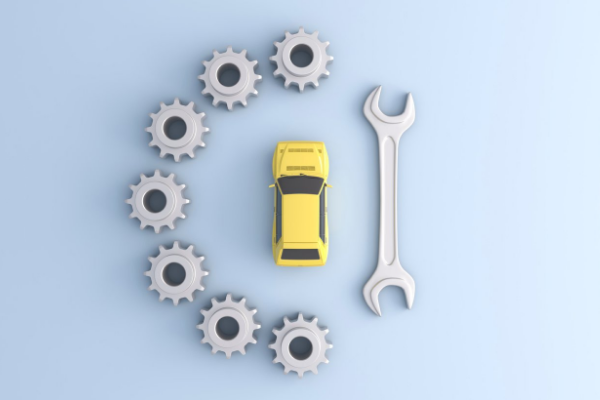Recon to Front Line Best Practices

Article Highlights:
- Dealers are having issues when reconditioning used vehicles.
- What forward thinking dealerships are doing to adapt.
Reconditioning vehicles and getting them to the front line as fast as possible is more important than ever. It’s one of the few controllables surrounding dealers’ inventory right now.
I sat down with Brad Schaffer, director and founder of ReconTRAC®, and Anthony Monteiro, COO of DRAIVER, to discuss reconditioning, front line best practices, and more.
__
Greg Uland: Brad, Anthony, it’s good to have you both here. In today’s world, inventory continues to be quite an issue. I’m excited to get input from both of you on how you’re seeing dealers handle it. Before we dive in, tell us a bit about you and your background.
Anthony Monteiro: I’m a relic in the business. I’ve been in the car business since 1989. Started selling cars in the front line, became a manager and a general manager. Early 1996, I met a guy and we started an internet car buying site called Automotive.com. Within three years, we were able to take that company public and that was an amazing journey, to be out in front of car buying on the internet. 1996 through 2000, we moved to California, did the whole dotcom bubble thing. From there, I learned a lot, started a consulting company of how to sell cars on the internet. After that, I bounced around a few different places in the industry but eventually found myself in Destin. That’s where I’m at now, Destin, Florida, where I started DRAIVER with a partner of mine. And now we’re moving cars at scale with the help of technology.
Brad Schafer: Much like Anthony, I could call myself a relic as well. I grew up as a son of a Matco Tools salesman, so I was around shops my whole life. I have about 25 years in retail with some of the big boys. I was with AutoNation for a while, then Asbury, then JM Family – I was the fixed ops director for the largest Lexus dealer in the country with them for a good amount of time. Eventually I started ReconTRAC to focus on reconditioning vehicles through the shop – that’s where I’m at today.
Greg: It’s amazing how everybody in this industry, once it’s in your blood, you can’t get out. You just want to stay in one way, shape, or form. It’s too fun being a part of this industry to get out of it. So it’s great to see the history with both of you.
Anthony: Not to jump off track here, but it’s funny, when I first got in the business, my degree was in architecture. I’m working at this big architectural firm, stock market crashes, and I get fired. They lay me off. So my neighbor says, let’s go sell cars. I’m like, OK, let’s do it. And the second week, the manager, Bob Campeau, looked at me. He said, you’re a lifer. He was from Boston with the heavy accent. So I had no idea what he was talking about. But, he said, you’re a lifer, you’ll be here for life. And I’m like, it’ll never happen. Here I am thirty plus years later.
Greg: It’s too much fun, that’s why you’re still here. All right, guys. Let’s start by setting the stage a little bit. Obviously demand right now is still outpacing supply, new and used. It’s no news there. But, on average right now, how long is a car sitting on a lot before it’s sold?
Anthony: Gosh, it’s probably a week or maybe less because some of the vehicles are actually being sold before they even get to retail.
Brad: The reconditioning piece of it is funny, right? People like to say, “well, we get this car out in three days,” but they forget to talk about things like “Anthony’s moving these cars around” and “I needed to send it down to the competitive dealer to get a recall done,” “I needed to get the car moved around the shop.” Internal communication is terrible. Believe it or not, the reconditioning of a vehicle historically has been around 12 days. 12.2 days is what we see on average. Because, when you start to talk about stocking the cars, in doing the first check, getting a car through the shop, through the body shop, you add up these cars that left for a recall a week and a half, two weeks. It’s bigger than you think it is. There’s some very different numbers out there, but we’ve seen excess of 12 days in total.
Anthony: Yeah, and on top of that, the problem is the actual movement of the vehicle, and that’s where we’ve come in working with reconditioning operations to say, “Hey, you’re taking two days off of the recon process, three days or four days. What about the time from when the vehicle is acquired?” There’s a lot of vehicle acquisition going on now. That’s just not trade-ins. People and companies are buying vehicles directly from consumers or directly from repair shops. How quickly can I get that vehicle from the acquisition point into the recon center? And then once it comes through recon, how fast can I get it out onto my retail lot or in some cases directly into the customer’s driveway as it comes out of recon? So if you take all that wasted time, put efficient processes around it, you really get down to a four or five-day total process.
Greg: If you think about it, if time from the lot to the sale is five to seven days, like you said Anthony, a week or less, but it’s 12 days from acquisition to the lot. I don’t think anybody would argue that shrinking that 12 days down is a problem they’d like to fix. But I guess it’s a fairly obvious one. So what’s preventing dealers from attacking it and fixing that problem in that lag time?
Brad: There’s a ton of problems right now. You’ve got technician shortages. You’ve talked about that before but it’s getting worse. People are very difficult to find. Internal processes. Some of the worst communication is inter-departmental between the body shop and sales all the way to the accounting department. You do a fairly decent job internally in your department, but when you’re dealing with a used car, this thing is touching everybody. I’m trying to reach out to Anthony to move cars. We’re trying to get that car stocked and inspected. We’re trying to get the parts. There’s just a ton of problems that can keep this car from getting to the front line quickly. And right now, the faster you can move these cars, the faster you can reinvest your money because you’re going to sell that car quickly. It’s now more important.
Anthony: Yeah. Half of what Brad just said about finding technicians is one thing, but now you have this whole issue of trying to find porters in an entry level wage employee job to come and work at that 15 to 20 dollar an hour range. The dealers can’t find them because they’re still getting some stimulus checks or they’re doing these other jobs that are paying more than that. And the other thing is, it is very unstable because when you look at that position, you might need to move 10 cars today and 40 cars tomorrow. You end up with these staffing issues. I don’t know what my volume is, and I’m sending these guys home early, or I don’t have enough work for them. I have too much work and I don’t have enough of those people. I’m not able to move the car. It’s really, really hard to manage right now without some of these processes and software applications that we’ll talk about.
Brad: I was talking to a dealer a couple of weeks ago out of Indiana, he knows the body shop industry as a whole. He was saying, it’s so difficult to find people, even worse in the service departments and a lot of areas are going to be shut down in his body shop. He just lost another tech that’s out for four months. And he had just slowly over years continued to lose people and he was getting ready to shut the body shop down as a whole, which is insane to me.
Greg: Yeah, absolutely. I’m thinking about these issues and maybe even inventory as a whole, what are you guys seeing on the horizon? What are you hearing out there? What are you seeing yourselves? Any relief coming down the pike here?
Brad: Yes, and no. Obviously, we’ve all heard about the chip shortages in parts and depreciation. We’ll talk a little bit about the depreciation of vehicles right now. We always use our mathematical formulas on how much you’re losing. It’s kind of the opposite way. Last year, if you had a bunch of cars, you’re making money on these things, but that’s not going to be forever. As these cars start to hit, there’s such a pent up demand for new cars right now. You’ve got thousands of cars sitting in the ports waiting for a chip or waiting for an armrest as those things hit the market. And you’re going to have those cars, plus the normal production of vehicles hitting these stores with a massive demand for sales. Which what’s that going to do? That’s going to dump used cars into the market. And when that pendulum swings, it’s going to be like nothing we’ve ever seen. Higher demand than we’ve ever seen on new when those hit at almost a double capacity from normal production. Plus the parts we’re waiting for, you’re going to have a ton of used cars coming in. We don’t know exactly when that will be, but that will be at some point in the future. It’s time to get your house in order today. Those that are sitting around sulking that you don’t have a lot of business right now, you’ve got to be ready for the future. And that time is right now.
Anthony: Yet again, on that point, you’ve got all these vehicles sitting at the ports ready to go, and when these parts come in and chips come in, now you’ve got this huge influx of vehicles that need to be moved somewhere and the logistics that needs to be in place to get them on your lot are a nightmare. Then when they’re on your lot, to be able to make sure that you’re able to get those vehicles somewhere else if you need them to lock rebalancing between dealer to dealer, somebody wants the Toyota at the Ford store. If dealers plan today for all of this influx of vehicles coming into their lots and then this new wave of used cars that are going to be available as more trades come in, how do I plan today to make sure all of these logistics and processes are in place so I can handle it? So I don’t get caught flat footed forever.
Brad: When you call Mick from the service department to run that car down the street or at least to take that car around the corner, you don’t have those associates. Not right there. There’s no valets. It’s a weird time in our industry.
Anthony: Think about the lack of communication. You’ve got the parts guy, you’ve got this service manager, and you’ve got the sales manager all telling these people to do all these things of moving cars here and moving them there. But none of them are really talking to each other. You touched on that point. Is the sales manager calling the service manager to say, “Hey, I have a service pickup and delivery, and I’ve got a home delivery, and I also need a car that goes to Rick.” What if you can connect all those together and just make it happen really easily and take away some of the cost and make it happen faster?
Greg: Yeah, that makes sense. All right, guys. Well, I want to be obviously respectful of your time. What else haven’t we talked about that we should?
Brad: A little bit, not just automotive, but how many times have you seen a sign in a store letting you know you’re going to get bad service? That’s insane. Or you walk into a restaurant and they’re telling you right up front, “We’re going to provide bad service.” I don’t remember in my lifetime that I’ve ever seen anything like this before. And I mean, it’s true. We’re short on people, but the great operators are going to figure this deal out. Forever we’ve been competing with competitors down the street that have the product. And it’s going to get back to that, but right now is the opportunity to figure this deal out. Figure out why people don’t want to work for you and fix that today or find the people that do and get your customer service and get your business in order today. Great operators, like I said, are going to win in the long run. Right now is a prime opportunity to get your business in order because others aren’t, and they think they have an excuse to do so.
Anthony: Customer service is really lacking. As a dealer operator, if you can get creative and be innovative, think about how you could wow a customer with what we’re talking about right now. Customer goes online, finds a vehicle they like before it even hits the front line. They watch it go through the recon process and then they watch it show up in their driveway like a Door Dash coming down the road, nice and shiny in their driveway. How about that for a customer experience? Dealers have to really get innovative because the market is changing. And if you don’t put these software applications and processes in place, you’re still going to fall way behind from the folks that are thinking that way and are going to deliver those services to really wow their customers.
Greg: Right. All right, Brad, Anthony, I really appreciate both of you taking time. For anybody that wants to learn a little bit more about ReconTRAC and about DRAIVER, where should they go visit?
Brad: ReconTRAC.com.
Anthony: And DRAIVER.com.
Greg: All right, sounds great. Again, appreciate both of your time and good luck out there. Have fun.
Anthony: Thanks for having us.
__
Brad and Anthony both shared some great insights about acquisition, front line ready best practices, and everything in between. If you want to listen to the above conversation, you can check it out on the Connected Podcast.
The automotive industry has seen a lot of changes recently and that’s not stopping any time soon. Like Anthony and Brad said, start preparing with the right processes and software now to be ready for the next change.
Related Articles:

Gen Z Loyalty: Why Traditional Strategies Aren’t Enough
62 percent of Gen Z consider multiple options even when they have a favorite brand. So how can you keep their extremely important business?

The Power of Personalization: How Direct Mail Can Transform Your Marketing
Consumers spend less time than ever inside dealerships, which means your window to communicate value has drastically narrowed. Customers today begin their search for service…

Harvesting Profits: Autumn Opportunities in Your Service Drive
As leaves begin to fall and jack-o’-lanterns light up porches, your service drive faces its own set of tricks and treats.

A Seamless Connection between Sales and Service
By fostering a seamless connection between these sales and service, you can create a holistic customer experience that not only drives sales but also ensures…















